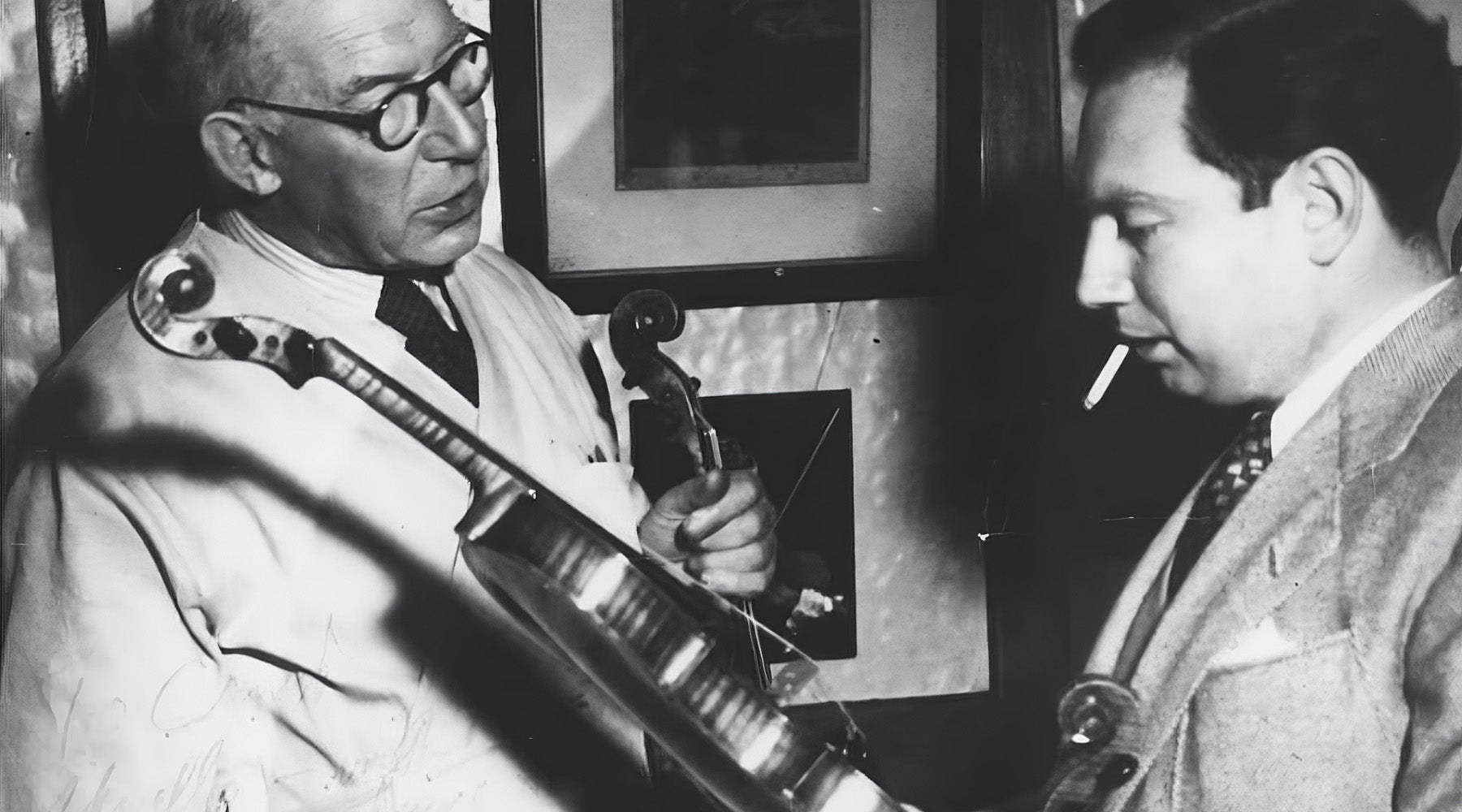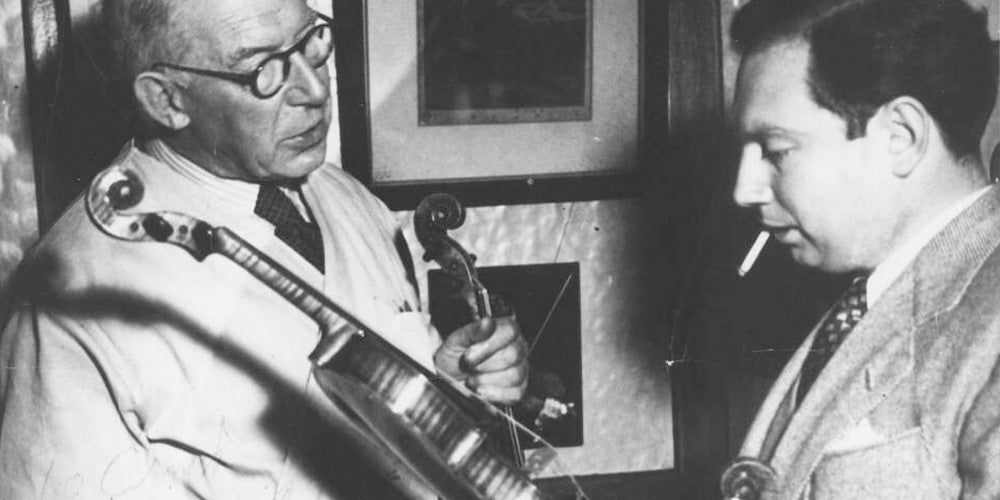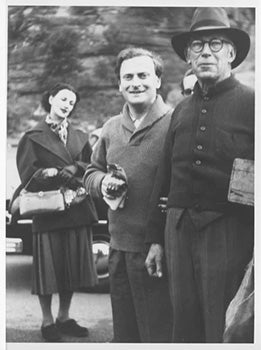BOOK AN APPOINTMENT
Book an Appointment


Today in both Australia & the wider global community, Arthur Edward Smith is considered the most important violin-maker to have been active in Australia. After migrating from London to Australia in 1909, Smith’s reputation began to grow. As his reputation grew, so did the prices for his violins, with one such example selling for USD $84,000 at a 2017 Tarisio auction. After passing away in 1978, certainly no other domestic maker has been so well regarded as A. E. Smith, despite there being a number of local violin-makers over the years. What is it then that sets Smith apart? Why are his instruments so well regarded & sought after, both locally & internationally?
Is the answer to this question in fact very simple? Is it that Smith’s instruments are the most superior examples of violin-making that we have seen to come out of Australia? If so, then what is it that makes Smith’s instruments stand out from other Australian violin-makers?
We are lucky enough to have seen a number of A. E. Smith violins pass through the store over the years. The maple & spruce used by Smith for his violins was of a particularly high quality. Even in the instruments made by violin-makers who trained or worked with Smith, we do not see the equal of his timber quality. Smith made a number of instruments after having a stroke in 1961. Despite the undeniably rough craftsmanship, these instruments are still in demand for their outstanding tonal quality. If indeed it is Smith’s instruments themselves that set him apart from other Australian violin-makers, it must be partly the wood that contributes to their exceptional sound if it isn’t always the workmanship.
Coggins says in his 2009 book ‘Violin & Bow Makers of Australia’ that Smith was ‘secretive’ about his violin-making methods. However, despite this secrecy, Smith allegedly shared his methods with his family members. It could then make sense that he was also sharing his wood supply with his family. In store we currently have a 1941 Kitty Smith violin & a 1952 A. E. Smith violin. Kitty’s violin has some beautiful timber used for its construction, most evident from the flaming on the back piece of maple. The superior quality of this timber is also heard in the outstanding sound & projection of her violin. However, the craftsmanship demonstrated in the construction of Kitty’s violin is far less superior to that of a golden period A. E. Smith.

Violin maker Arthur Edward Smith at work, c.1951.
Photo courtesy of the National Library of Australia
Smith was initially a self-taught violin-maker. This means he had no pre-existing bias from a teacher or school when first learning to make instruments. Coggins says that Smith played in the ‘Maldon Amateur Orchestral & Dramatic Society’ while still in England & had only a sub-standard instrument to play. Using some violin-making books, he addressed the problem & made himself a better instrument. Smith began making instruments to solve a problem. He had a bad violin, and rather than persevere, he made a better one. Initially, Smith was not making violins to achieve perfection or to make an exact copy of an old master’s violin. This combined with Australia’s location being so isolated from Europe & the U.S. could have given Smith the necessary space & freedom to take a little more creative license when constructing his instruments, making them particularly exceptional.
Over the years, Smith employed a number of trainees at his Sydney based shop. However, as mentioned above Smith was allegedly quite resistant to pass on his own personal violin-making methods. If even his employees could not replicate what he was doing, this could also have contributed to what makes Smith’s instruments so exclusive. It is quite common for violin-makers to keep their secrets & this is partly why there is so much speculation in regard to the old Cremonese instruments & their alleged superiority.
It may not have been that Smith didn’t want to share his personal methods, but rather that there just wasn’t time. Primarily, Smith was running a successful & busy violin-shop while facing frequent health problems. Coggins says that Smith’s employees were not meant to make instruments during the shops opening hours. If they were going to make instruments, it had to be during their own time. However, Smith did not make instruments during the shops opening hours. He made instruments while at his own private workshop during his spare time. Rod Smith (A. E. Smith’s grandson) told Coggins that Smith used to show his employees the accepted way of doing something in the making process but may not necessarily have shown them exactly how he did it. Because Smith had a natural talent for instruments that he made without bias, & didn’t pass on his exact methods of making it gave his instruments a unique edge & helped them to stand out.
However, when determining why one violin is more well-known or preferred over another, it is not often simply about the instrument itself. The violin is often treated as a work of art rather than as an object with which to make music. I think the answer to my initial question of ‘why are Smith violins so highly sought after’ is more complicated than the most obvious answer of ‘well his instruments are just better.’ Unfortunately, a beautifully crafted instrument does not always speak for itself. You have to be more than just a good violin-maker to be successful. You have to be an entrepreneur, a manager and a strategist. The reputation that Smith has left behind has to be the result of more than just good craftsmanship. How did Smith get his name out to the community in the first place?
Smith’s reputation could be attributed to the fact that he was in the right place, at the right time. When Smith migrated to Australia from England in 1909, there was a lot of change happening in the Australian music scene. The Melbourne Symphony Orchestra was founded in 1906, The Australian Symphony Orchestra (later to become the Sydney Symphony) in 1908 & the other State Orchestras followed shortly afterwards. The New South Wales Conservatorium of Music opened in 1916 & by 1919 Smith had opened a shopfront ‘A. E. Smith & Co. Pty Ltd.’ The 1920’s was one of the most successful times for the shop in terms of business & the amount of staff he had in employment. While Smith was one of the first to migrate to Australia, he was not the first violin-maker to arrive & he was not the only maker who was active during this period. What made people choose to go to Smith over some of the other makers who were active during this same period?
Smith was not only making instruments, he was repairing them & selling a range of accessories, including bridges, rosins, shoulder-rests & even violin strings all made on site. They also sold tonewood, fittings, & a ‘Smith’s oil varnish.’ There was difficulty importing items from Europe during this time, so Smith manufactured accessories locally to fill the gap. People could go to Smith, a highly regarded violin-maker to purchase a violin, get their existing one repaired, purchase all their accessories & ask advice about violin-making all under the one roof. Smith made himself known as an expert at the time. He was giving lectures at the ‘Farmer’s Blaxland Gallery’ on various topics relating to violin-making & restoration. These kinds of functions helped to get his name out & maintain his reputation.
However, what seems to speak the loudest to me is the legacy that Smith left behind him. Opposed to many violin makers who prefer to work in isolation with their craft, Smith set up a diverse shop that specialised in quality orchestral stringed instruments, supplies, repairs & restoration that filled a real gap in what was already happening within the growing music industry in Sydney. Smith employed a number of apprentices who went on to become well-known local makers such as Guy Aubrey Griffin, William Dolphin, Lloyd Adams, Ronald Cragg, Phillip Burgess, Cedric Clarke & Harry Vatiliotis. Smith provided a space for the learning & transfer of knowledge between violin-makers & restorers of the time. Many amateur violin-makers credit Smith as helping them to get started or providing tailored advice & templates.

Portrait of Arthur Edward Smith, Yehudi Menuhin and Mrs Menuhin, 1951.
Photo courtesy of the National Library of Australia
Prominent violinists of the time such as Isaac Stern, Ruggieri Ricci, Yehuidi Menuhin & David Oistrakh sought out Smith while travelling through Australia for repairs or to purchase an instrument. While travelling to Australia, Ricci’s violin was damaged & Smith was asked to restore it. When Ricci then gave a performance at Sydney Town Hall, he used one of Smith’s instruments & many presumed that he was using his own Guarneri.
In July 1949, he was awarded a diploma of honour for violin & viola at the ‘Modern Violin Making Competition & Exhibition’ at The Hague & he was the first Australian to be chosen as a member of the International Society of Violin & Bow Makers. In 1970 at 90 he stopped making violins & in 1971 Smith was named a Member of the Order of the British Empire. There is a quartet of instruments on display at the National Museum of Australian in Canberra the Powerhouse Museum in Sydney. These achievements and connections assisted in raising the overall reputation of Australian violin makers & musicians. Many makers or performers who did have a connection to the Smith workshop were taken more seriously overseas by association.
Smith’s acclaimed reputation here in Australia could quite simply be a result of his nationality as an Australian. We love to support locally made products & businesses & we are proud that such beautiful instruments are the result of an Australian craftsman. Smith made a finite amount of instruments & having one of his instruments has almost become a claim of being a proudly Australian musician. However, if we were to attribute Smith’s reputation purely to the credit that we as Australian’s give him for being a fellow Australian, this would not account for the international legacy of excellence that his reputation has attained. There is no denying that Smith was a superior craftsman & that his instruments are exquisite examples of craft. But what is it that sets Smith & his instruments apart? I think that the timing of his move to Sydney, the diverse nature of his shop & the legacy of excellence that he left behind has collectively raised the reputation of Smith & his instruments, making them more sought after within both the local & international Australian violin-making community.
Laura Case is The Sydney String Centre's showroom manager and fine instruments specialist. Laura studied Music and Education (Honours) at The University of New South Wales, completing a thesis entitled Innovations and the Stradivari Conundrum; Psychological, Sociological and Emotional but not Musical.